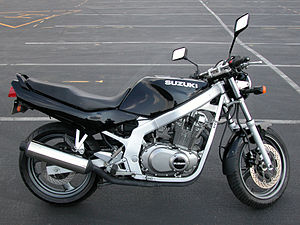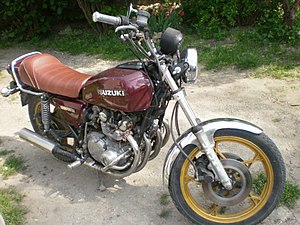Suzuki GS500

1997 Suzuki GS500E
|
|
| Manufacturer | Suzuki Motor Corporation |
|---|---|
| Also called | GS500E GS500F |
| Production | 1989–2012 (GS500 / GS500E) 2004–2013 (GS500F) |
| Assembly | Japan 1988-2003 Gijón, Spain 2004-2013 Pereira, Colombia 2014— |
| Predecessor | Suzuki GS450 |
| Class |
Naked bike (GS500 / GS500E) Lightweight Sport bike (GS500F) |
| Engine | 487 cc (29.7 cu in), 4-stroke, air‑cooled parallel twin, DOHC, 2 valves per cylinder |
| Bore / stroke | 74.0 mm × 56.6 mm (2.91 in × 2.23 in) |
| Compression ratio | 9.0 : 1 |
| Top speed | 185 km/h (115 mph) 159 km/h (99 mph) 169 km/h (105 mph) |
| Power | 51.3 hp (38.3 kW) @ 9500 rpm (claimed) 38.1–40.5 hp (28.4–30.2 kW) (rear wheel) |
| Torque | 30.4 lb·ft (41.2 N·m) @ 7500 rpm (claimed) 25.6–26.7 lb·ft (34.7–36.2 N·m) (rear wheel) |
| Ignition type | Transistorized electronic ignition |
| Transmission | 6-speed |
| Frame type | Duplex cradle |
| Suspension | F: Telescopic, spring preload adjustable R: Link type, spring preload adjustable |
| Brakes | F: Disc, twin-piston caliper R: Disc, single-piston caliper |
| Tires | F: 110/70-17, R: 130/70-17 |
| Rake, trail | 25° 30′, 95 mm (3.7 in) |
| Wheelbase | 1,405 mm (55.3 in) |
| Dimensions |
L: 2,080 mm (82 in) W: 800 mm (31 in) H: 1,060 mm (42 in) (GS500), 1,150 mm (45 in) (GS500F) |
| Seat height | 790 mm (31 in) |
| Weight | 169 kg (373 lb) (GS500E) 174 kg (384 lb) (GS500) 180 kg (400 lb) 184 kg (405 lb) (GS500F) (dry) 193 kg (425 lb) (GS500) 199 kg (439 lb) 201 kg (443 lb) (GS500F) (wet) |
| Fuel capacity | 17.0 l (3.7 imp gal; 4.5 US gal) 20.0 l (4.4 imp gal; 5.3 US gal) (2001—) |
| Fuel consumption | 56.3 mpg‑US (4.18 L/100 km; 67.6 mpg‑imp) |

Inline-four engine GS500E model
|
|
| Manufacturer | Suzuki |
|---|---|
| Production | 1979-1982 |
| Class | Standard |
| Engine | 492 cc (30.0 cu in), 4-stroke, 4-cylinder, air-cooled, DOHC 2 valves per cylinder |
| Bore / stroke | 53.0 mm × 55.8 mm (2.09 in × 2.20 in) |
| Compression ratio | 8.5 : 1 |
| Transmission | 6-speed constant mesh |
| Brakes | F: Dual disk R: single disk |
| Tires | F: 3.25-19 R: 3.75-18 |
| Wheelbase | 1,435 mm (56.5 in) |
| Dimensions |
L: 2,200 mm (87 in) W: 850 mm (33 in) H: 1,155 mm (45.5 in) |
| Seat height | 835 mm (32.9 in) |
| Fuel capacity | 17.0 L (3.7 imp gal; 4.5 US gal) |
| Related | GS550 |
The Suzuki GS500 is a popular entry level motorcycle manufactured by the Suzuki Motor Corporation. Suzuki produced the GS500 and GS500E from 1989 onwards and a fully faired model, GS500F from 2004 onwards. The GS500 is currently being produced and sold in South America.
The unfaired version of the GS500 was first sold in the UK in 1988 (model code GS500EJ) and the following year's model (code GS500EK) was released for sale in Europe and North America. It was equipped with an air-cooled parallel twin-cylinder engine derived from the earlier GS450. In the motorcycle market, the GS500 occupied the low end of Suzuki's mid-sized range for over twenty years.
Suzuki also produced GS500 models, identified by a 'U' suffix, with engines restricted to satisfy the maximum power-to-weight ratio for use in countries where restrictive motorcycle licenses were issued (the GS500 meets current EU and UK licence level A2 conditions without restricting the engine) or for countries with a Learner Approved Motorcycle program (such as Australia and New Zealand) enhancing its worldwide popularity.
GS500 engineering lineage descends directly from Suzuki's first modern 4-stroke motorcycles. With the 1976 debut of the GS750 air-cooled inline-four, as well as the GS400 parallel-twin, Suzuki was building 4-stroke engines despite having produced only 2-stroke motors for 20 years. The Suzuki GS series soon expanded into larger and smaller four-cylinder bikes, the GS1000 and GS550 respectively, while the twin-cylinder engine was bored-out to become the GS425 twin. All of these models preserved the earliest GS engine layout: double overhead cams, 2 shim-adjusted valves per cylinder and a roller-bearing crankshaft.
The GS500E motorcycle appeared in 1979, powered by a sleeved-down version of the GS550 engine (with smaller carburetors). The GS500E four was manufactured for markets where its smaller displacement was suited to insurance or license regulations.
Suzuki modified the original GS series engine layout to produce a successor to the GS425, the GS450 twin, which had a new bottom-end design that used a one-piece 180° crankshaft running on plain bearings. A counterbalance shaft controlled engine vibrations. The 448 cubic centimetres (27.3 cu in) displacement of this twin grew to 487 cubic centimetres (29.7 cu in) in 1988 by means of a 3 mm larger bore, when it became the engine for the new GS500E.
...
Wikipedia
